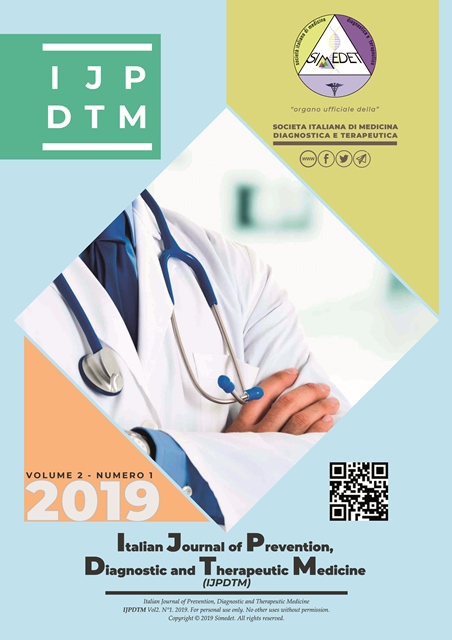Preparation for the next major incident: the case report of Gubbio
Main Article Content
Abstract
In maxi-emergencies, disproportion between extraordinary medical request and adequate medical response is always a challenging, typical matter. The goals are clear: offering the best and most qualitative and fast-paced medical solutions for population and reduce as much as possibile the morbility and morbidity burden. In this article we review the management of a maxi-emergency in the higly seismic area setting of Gubbio (Italy) underlining any possible consequences of an earthquake in this geographic area. We review the management of an extraordinary medical response in this area and evaluate the best emergency exit ways and best Advanced Medical Headquarter strategical points; moreover we discuss about the best strategies according to efficient triage modalities, traffic and road management and possible “bottleneck” pitfalls. Massive injured people Emergency Plan (a.k.a. PEIMAF) is also discussed according to the Hospital actual medical response and capability. Despite the number of injured patients and complexity of the clinical cases, the Medical response need to be efficient and highly organized. Moreover the main coordinating role and freedom of intervention of the clinical leader and his staff is accurately reviewed.
Downloads
Article Details

This work is licensed under a Creative Commons Attribution-NonCommercial-NoDerivatives 4.0 International License.
References
Haessler, H., Gaulon, R., Rivera, L., Console, R., Frogneux, M., Gasparini, C., Martel, C., Patau, G., Siciliano, M. & Cisternas, A., 1988. The Perugia (Italy) earthquake of 29 April 1984: a microearthquake survey,Bull. seism. Soc. Am.,78,1948–1964.
Aylwin CJ, Konig TC, Brennan NW, Shirley PJ, Davies G, Walsh MS, Brohi K: Reduction in critical mortality in urban mass casualty incidents: analysis of triage, surge, and resource use after the London bombings on July 7, 2005. Lancet. 2006, 368: 2219-2225.
Advanced Life Support Group (Ed.): Major Incident Medical Management and Support, the Practical Approach at the scene. 2002, Plymouth, UK: BMJ Publishing Group, Second.
(Legge n. 225 del 24 febbraio 1992: istituzione del Servizio Nazionale della Protezione Civile.)
Health disaster management: guidelines for evaluation and research in the Utstein Style. Volume I. Conceptual framework of disasters. Task Force on Quality Control of Disaster Management; World Association for Disaster and Emergency Medicine; Nordic Society for Disaster Medicine. Prehosp Disaster Med. 2003;17 Suppl 3:1-177.
Turris SA, Lund A. Triage during mass gatherings. Prehosp Disaster Med. 2012;27(6):531-5.
Jenkins JL, McCarthy ML, Sauer LM, Green GB, Stuart S, Thomas TL, Hsu EB: Mass-casualty triage: time for an evidence-based approach. Prehospital Disaster Med. 2008, 23: 3-8.
Aylwin CJ, Konig TC, Brennan NW, Shirley PJ, Davies G, Walsh MS, Brohi K: Reduction in critical mortality in urban mass casualty incidents: analysis of triage, surge, and resource use after the London bombings on July 7, 2005.
Atto di indirizzo e coordinamento alle Regioni per la determinazione dei livelli di assistenza sanitaria di emergenza G.U. n 76 del 31/03/1992 “Pianificazione dell’emergenza intra-ospedaliera a fronte di una Maxiemergenza”: (Bindi,Settembre 1998)(29-37).
Bhalla MC, Frey J, Rider C, Nord M, Hegerhorst M.Simple Triage Algorithm and Rapid Treatment and Sort, Assess, Lifesaving, Interventions, Treatment, and Transportation mass casualty triage methods for sensitivity, specificity, and predictive values.Am J Emerg Med. 2015;33(11):1687-91.
https://ugeo.urbistat.com/AdminStat/it/it/demografia/dati-sintesi/gubbio/54024/4
Brennan L, Sage F J, Simpson A. Major incident planning in South East Thames Region: a survey of medical staff awareness and training. J Accid Emerg Med 1994;1185–89.
Ardagh MW, Richardson SK, Robinson V. The initial health-system response to the earthquake in Christchurch, New Zealand, in February, 2011. Lancet. 2012;379(9831):2109–15.
Aylwin CJ, König TC, Brennan NW, et al. Reduction in critical mortality in urban mass casualty incidents: analysis of triage, surge, and resource use after the London bombings on July 7, 2005. Lancet. 2006;368:2219–25.
Biddinger PD, Baggish A, Harrington L, et al. Be prepared — the Boston Marathon and mass-casualty events. N Engl J Med. 2013;368(21):1958–9
Philippe J, Brahic O, Carli P, Tourtier J, Riou B, Vallet B. French Ministry of Health’s response to Paris attacks of 13 November 2015. Crit Care. 2016;20:85.
Peleg K, Reuveni H, Stein M.Earthquake disasters--lessons to be learned. Isr Med Assoc J. 2002 May; 4(5):361-5.

